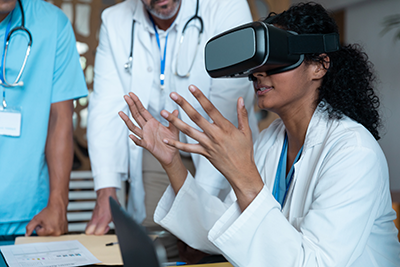 Virtual reality and expanded simulation training are making their way to medical education in Huntsville.
Virtual reality and expanded simulation training are making their way to medical education in Huntsville.
Thanks to grant funds from the Comprehensive Urban Underserved and Rural Experience (CU2RE) Program in the UAB Department of Family and Community Medicine, leaders on the Huntsville Regional Medical Campus (HRMC) have purchased four virtual reality simulators to help medical students understand sensory issues their patients experience and are building a simulation lab on the campus building’s first floor.
“Bringing new technology to the campus will prepare our medical students for practice, adding to the already excellent in person experience they gain, the VR technology can allow them to feel the symptoms and sensory issues their autistic and other patients might have,” said Roger Smalligan, MD, MPH, dean of the Huntsville Regional Medical Campus. “We are grateful to Dr. Irfan Asif, both for his vision for the CU2RE Program and for his willingness to help fund expanded medical student training in Huntsville.”
Smalligan said the campus purchased four virtual reality simulators and the information technology team is working to create secure networks so the equipment will be ready to use in the coming weeks. The campus is working closely with the Lister Hill Library to take advantage of applications the university is already under contract with to promote the best learning methods for the VR helmets.
Another development on the UAB Huntsville campus is a new simulation lab being built out on the HRMC’s first floor, which will give students first-hand experience with common procedures.
The new patient simulators include both an abdomen and upper body that can be filled with fluid for students to ultrasound, prep and drain; a torso that simulates heart and lung sounds; wrists and arms for practice placing arterial lines and IVs; and a pelvis, simulating births. The campus has also purchased several point of care ultrasound (POCUS) systems to support the training.
Smalligan said the most important of the simulators are the central line trainers, which help students and residents learn how to properly prep and drape a patient and then use the handheld ultrasound to find the critical blood vessels in the neck and safely place a central line, minimizing the risk of damage to the carotid artery or causing a pneumothorax.
“While almost all students benefit and are interested in learning procedures, it is especially important for those planning to practice in smaller, rural areas where interventional radiology is not available” he said. “Having this hands-on training helps students develop skills that will serve them well in the future —whether they’re working in a hospital setting or an outpatient clinic.
Smalligan said he expects the simulation lab to be opened and fully operational later this fall.